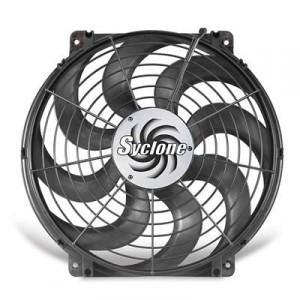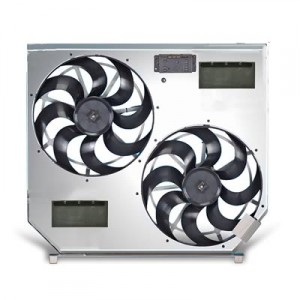 A couple weeks back, we asked the question: Mechanical vs. Electric Fans: Which is Best for Your Vehicle? If you’ve determined that an electric fan is the best choice for your ride, you’re certainly not alone.
A couple weeks back, we asked the question: Mechanical vs. Electric Fans: Which is Best for Your Vehicle? If you’ve determined that an electric fan is the best choice for your ride, you’re certainly not alone.
Electric fans have become the preferred choice for many enthusiasts because they have lots of advantages over mechanical fans, including:
- Good cooling with no parasitic horsepower loss
- Consistent cooling—they maintain their airflow at all times
- Versatility—they can be mounted in front of or behind the radiator
- Multiple sizes and configurations—they can be found in diameters up to 20 inches and are available with single- and dual-fan setups
The next logical question is: “Which electric fan is right for my vehicle?”
With help from our friends in the Summit Racing tech department, we’ve identified four keys to choosing the right electric fan for your application.
1. Establish the Need
If you haven’t read our original post on mechanical and electric fans, start there. You’ll learn that, in some cases, the stock clutch fan or an aftermarket flex fan will work just fine.
Remember, though, a mechanical fan is driven by your engine. If your engine is spinning at low rpm, so is your mechanical fan—and that means there will be less airflow at lower engine speeds. If you notice your vehicle running a little hot in traffic or at low rpm, an auxiliary electric fan may be just what you need to give your primary fan a cooling boost.
2. Determine Optimum Airflow
Most aftermarket fan companies rate their electric fans by horsepower and airflow levels—simply choose the one that is rated the same as or higher than your vehicle’s power output or airflow requirements.
As a general rule of thumb, follow these minimum cubic feet per minute (cfm) ratings when using an electric fan as the primary cooling source on a basic engine:
- 1,250 cfm for a 4-cylinder
- 2,000 cfm for a 6-cylinder
- 2,500 cfm for a 8-cylinder
Engines that are 5.0-liter (302 cubic inches) or larger should use an electric fan with 2,800 or more cfm. Obviously, an 800-horsepower engine will need more cooling than a 300-horsepower powerplant regardless of the cylinder count. Again, many electric fans are rated by recommended horsepower to help you get the optimum amount of airflow.
3. Measure It Up
Once you know the minimum cfm required, you need to determine what will physically fit. This is easiest to do if you remove the belt-driven fan and fan shroud so that you can accurately measure the radiator and the distance between the radiator and engine components.
You should also measure the radiator core, which is the finned surface between the two tanks. You’ll want to select a fan that covers as much of this space as possible. In many cases, you will be better off with a dual fan because the shroud will pull air through a larger area of radiator than a single fan.
Next, measure the distance between the radiator core and the closest engine component. You can then supply these dimensions to your sales rep.
4. Choose Pusher or Puller
Electric fans are available in pusher or puller designs. Pusher-style fans mount on the front of the radiator and blow air through the radiator core. Puller-style fans mount behind the radiator and draw air through the core.
Puller-style fans are recommended for applications in which the electric fan is the primary cooling source. A pusher-style fan can be used as an auxiliary cooling source, but you should sure make the fan covers as much of the radiator core as possible. This goes back to measuring and determining the right dimensions for your fan.
Don’t spend valuable cruise or car show time sitting on the side of the road. Take the first four steps toward avoiding an epic summer meltdown—and keep your ride firing OnAllCylinders!


[…] have the proper radiator and fan in place. Hopefully, you’ve done your homework and read our Aftermarket Radiators 101, How to Choose and Aftermarket Radiator, and How to Choose an Electric Fan in 4 Easy Steps posts. […]
If you think an electric fan is better try feeling the output hose temperature of the radiator of an electric fan vs. Mechanical fan and then still tell me that the electric fan is better
you obviously have never been sitting in heavy traffic with a 700hp big block at idle, mechanical fans rely on engine rpm
On some builds you have no choice but to use an electric fan.
John, you ain’t kidding! Try 550 rwhp with 11:1 compression. I have to put the heat on High, just to get the temp down when it’s 100*! Replaced the mechanical clutch fan and just fit 2-16″ fans with a custom cowling. If I turn on the AC, the temp stays 180*. I’ve rigged it up to dual adj thermostats and also to the AC pump power source. Dual 3000 cfm fans and the headers like the breeze too!
I need an electric fan to cool a 350 V8 that we just installed in my 1965 Chevelle. Cooling components does not seem to have one that will fit this car. I need at least 2500 CFM.
Thanks
Paul V Haddaway
I NEED AN ELECTRIC FAN to cool a 350 V8 we just installed in my 1865 Chevelle. Cooling components does not seem to have one that will fit this car.I would like to have 3500 CFM.
1865? before its time, no? LOL
I still want an electric fan setup on my ZZ3. In my 50 merc stock radiator,rebuilt Can someone share what i should use. This fan chasing is driving me nutz. This a show Mercury i bought a fan from summit that was a pusher–tYPE at summit. Please tell me what to buy BOB SCHARP
I’ve got a ’69 Camaro with a mild built 454 (461) and my straight mechanical fan and 4-core COPO-style OEM radiator worked fine as long as the car was moving and notvstuck in bumper to bumper traffic. I’m in the process of switching to a 2-tube (1.250″ tubes) aluminum radiator, but also adding a serpentine belt system. I’m expecting I’ll need a dual fan setup, but trying to find a super thin shroud and high CFM fan combo that will fit in the 2-1/2″-3″ of clear space between pulleys and belt is a challenge. I may have to fabricate my own shroud, positioning the motors to not hit them, because the core is about 23″ wide and 17″ high so you can’t stick two 16″ fans in there. I’d love to find a 11″ pancake fan that’s maybe 2″ thick max, and puts out 1800 CFM.
One thing I’d like to see is some CFM specs on a stock fan at idle, and maybe 1500 rpm. It’s a given that once you surpass 30 mph, the air being pushed thru the grille/radiator surpass what the 7-blade mechanical fan can pull, that’s why clutch fans disengage when enough cool air flows over the fans coil. Likewise, most eFans are wired so they only come on when coolant temperatures surpass say 195 degrees, then shut down at 180. So in a nutshell, your eFan setup not only saves horsepower, it does a better job at idle and low rpms than a mechanical fan because it can run at full speed or perhaps half speed if it’s a two-speed setup.
I put dual 12 inch 80 watt each 2150 CFM each cooling fans on my 1966 nova 350/350 HP. Does the relay determine the CFM of the fans and how can I measure the CFM’s to make sure I’m getting the amount that is advertised. Some advertise a 60 amp relay others a 40 amp I am assuming each fan. I hope you can help me with this problem.My family car spins very fast when the AC kicks on what do I need to do to make the fans on the nova spin faster. Thanks Barry The Nova has AC but cannot use in heavy traffic.
I have a pusher & puller for my 92 camaro. Still runs hot …
I have a 600 c.i. bbf in the 1000 hp. range. Summit carries perma cool dual fans #19501 replacement for the 5.0 fox body rated at 6000 cfm. Why would they sell that set up for that engine? With such a high cfm rating how do you know your getting what they say? That set up would be more suited for my engine. My engine is running hot and lm not sure about the cfm rating ? Any help would be appreciated. Thanks
interesting everybody says they put all theses fans to solve their problems & not one of them said the brand or wher they got it .
I have a 1946 Ford Tudor Sedan with Ford 302 engine basically stock I have to put in a push fan don’t have room for a pull fan, I go a Walker Radiator with a ac condenser on front of radiator and transmission cooler in radiator. I’ll be mounting a fan in front to blow through condenser and radiator, how many cfm’s fan would I need? And do I need a shroud to cover condenser and radiator?
I have a 1929 Ford pickup with a 302 Ford engine in it and it gets hot at 80 or more temp what electrical would work to keep it cool?
[…] https://www.onallcylinders.com/2012/08/14/fan-club-how-to-choose-an-electric-fan-in-4-easy-steps/ […]
One thing I have not seen in the above comments was the importance of having a proper fitting shroud along with the electric fan, this is a must to concentrate the air flow.